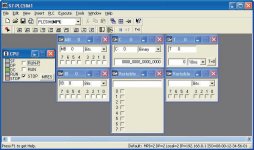Hey guys I'm new with the usage of PLC and I'm soo looking for your help. I have an S7 300 seimens device which I start to learn about it and I have downloaded S7 sematic version 5.4 SP5 and started working on it. I built a sequential program using S7 graph but I want to simulate it on the S7-PLCSIM but I don't know how to enter the inputs and how to view the outputs in the simulator plz help me out. Any stuff for a beginner would be great, Thanks in advance
how to use S7-PLSIM simulation module to simulate S7 graph sequential
- Thread starter ghanim
- Start date
Similar Topics
Hi,
I would like to assemble a simulator/practice booster pump system that uses PID to maintain steady water pressure under various outlet demands...
I am trying to set up a piece of equipment with a Horner HE-X4R. I'd like to use structured text and so far I'm just trying to get a basic On/off...
hello every one.
i'm new to tiaportal, i have created new project and HMI screen
the program works fine with PLC-sim, but when i try to cntrol the...
I am looking to upgrade a CompactLogix on V18 to an L83E on V32 which is currently using a Beijer E1151. Does anyone know if the E1151 is directly...
I use the HMI simulation as our production lines are pretty big and we've put an upgrade in over the last couple of months and I've used it most...





